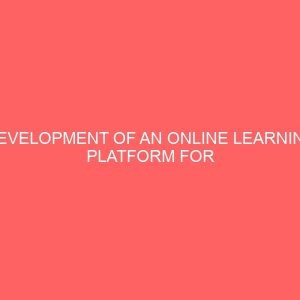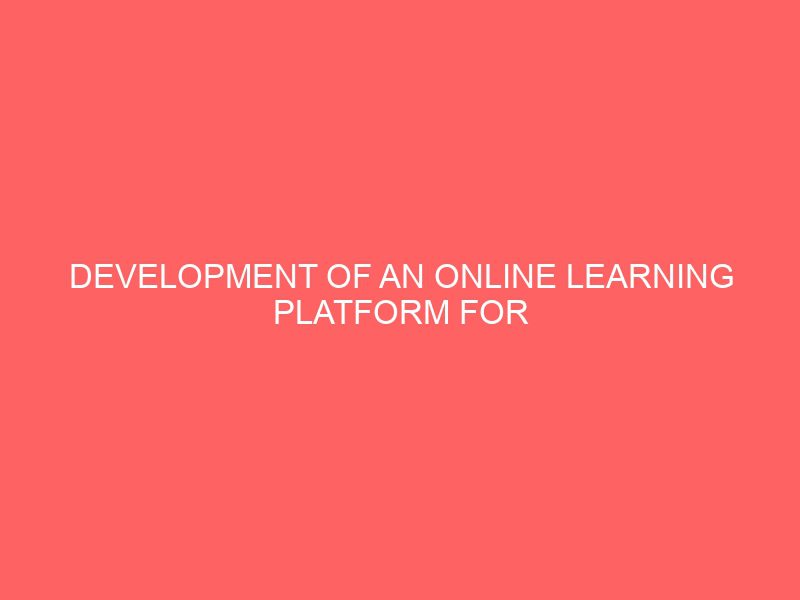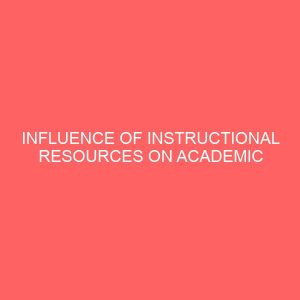Description
CHAPTER ONE
INTRODUCTION
- BACKGROUND OF THE STUDY
The internet has drastically modified the traditional way that organizations communicate with the general public. For organizations, the web gives access to large viewers and enhances functional performance. Websites are emerging as a key component of an organization’s survival or success in our ever globalizing competitive world. The website symbolizes an organization, interacting an organization’s principles, culture, values, vision and perspective. The website serves as a mechanism for delivery of services that assist in various projects a stakeholder needs to accomplish. The website also serves as a means through which an organization and its stakeholders communicate with each other.
Academic institutions are also using the web to establish visibility and to offer computing services to its students, staff and faculty. Mebrate, asserts that academic institutions use websites for wide variety of purposes, which includes the distribution of information to the public, delivering online learning facilities to students, promotion of their educational and research programs and the like, (Mebrate, 2010). Based on the assertion above it can be unarguably concluded that there are three major functions of a university website: Promotion and marketing, Online services and providing a vehicle to communicate between individuals and groups.
Therefore Mebrate (2010) clearly spelt out some of the uses of academic websites as related in one way or another to the following tasks:
- Promotion of research and education programs (Bachelor, Masters and PhD).
- E-learning support to students.
- Communication means towards the public community.
- Advertising vacancies for different positions in the university.
Promotion of research and education programs of the academic institution is the fundamental purpose of academic websites. Faculties or schools in a university can use the website to advertise their education programs to future students aspiring to study in one of the fields of study the university offers. Information such as entrance requirements to a specific program, application procedures, fee, contact information and important dates the students should know can be made available on the academic’s website to ease the communication of information to students.
The website is also used to facilitate the teaching learning process by providing e-learning support. The academic institution also uses the website to disseminate important achievements in completed research projects, changes in education programs and the like to the public. Research companies that are interested to work in collaboration with the university can also get specific information they want from the website. The website is also used to advertise open positions in the university.
There are different groups of users of academic websites. Each user group has different requirements and expectation from the website. Main users of academic website include:
- Students
- Current students: PhD, Masters, Bachelor.
- Prospective students: PhD, Masters, Bachelor.
- Professors
- Researchers
- Journalists
- Schools
- Companies
- Parents
Obviously, when prospective students check out the academic institution website, the anticipation is that any issues regarding a particular program being offered will be responded to. As Sites are designed and developed in a different ways, it is possible that website visitors will find it very difficult in getting the solutions they need due to issues of website usability (Bautista, 2010). Moreover, academic institutions need to indulge within their strength to keep positive images with their various constituents, and the way to do this is to take full advantage of the opportunities the website provides (Caglar & Mentes, 2012). Almost all academic institutions take full advantage of their websites as a key public relation and marketing tool to reach potential students. Potential students may be more likely to apply to the academic institutions that provide useful and clear information on its website. The students may see other students in their roles that wish to search for other institutions.
University websites are no exception. University website major aims are to provide up-to-date information and services to students, lecturers, administrators and other users in efficient ways. Through this website, university staff may access employment information from Human Resources, faculty may access student class lists and enter grades, and students may access course materials, grades, register semester courses, upload credentials and financial aid information. One major benefit of a university website at the institutional level is the ability to access all of this information using only a single sign-on. The university website is not only a cost efficient and timely method to communicate with various stakeholders such as students, faculty, administrative staff and visitors it is also a way for a university to shape its image. Universities need to do everything within their power to keep positive images with their various constituents, and one way to do this is to make use of the opportunities website presents.
Observations mentioned above explicitly highlighted the importance of usability issue for the websites. Usability has gained a great deal of importance and popularity in terms of satisfying website users’ needs and expectations. Usability has been a popular theme that is extensively studied in the field of human-computer interaction (HCI) field (Shneiderman, 1998). Aldwyn (2011) argues that usability is a requirement to survive in internet environment. Nielsen (2000) states the usability rules the web. The same author argues usability is an extremely important aspect of individual website and overall website design. So, web design must directly face users with the specific needs. Although, it is difficult to satisfy all users needs because each of these user groups has their own specific requirements and expectations from the website however evaluating the website from time to time will greatly enhance the usability of a website and must make sure that users are pleasant to successfully complete tasks with web.
ISO 9241-11 defines usability and explains how to identify the information which is necessary to take into account when specifying or evaluating usability of a visual display terminal in terms of measures of user performance and satisfaction. Guidance is given on how to describe the context of use of the product (hardware, software or service) and the relevant measures of usability in an explicit way. In particular, ISO 9241- part 11 defines usability as the “extent to which a product can be used by specified users to achieve specified goals with effectiveness, efficiency and satisfaction in a specified context of use” (ISO, 1998).
For any organization to strife in the global world nowadays through its website, usability most be seen as an important factor to success. That is why Aldwyn asserts that in internet environment usability is an essential requirement (Aldwyn, 2003). So, Web design should focus solely on website’s users to enhance its usability. Web design must conform to specific user needs, and must also make sure that users are satisfied to successfully carry out tasks with website without encountering any issues.
Website usability is the ease of use of a website. Some broad goals of usability are the presentation of information and choices in a clear and concise way, a lack of ambiguity and the placement of important items in appropriate areas. Another important element of web usability is ensuring that the content works on various devices and browser. Website usability is very important on the Web, because it is a necessary condition for survival. If a website is difficult to use, people leave. If the homepage fails to clearly state what a company offers and what users can do on the site, people leave. If users get lost on a website, they leave. If a website’s information is hard to read or doesn’t answer users’ key questions, they leave. Note a pattern here? There’s no such thing as a user reading a website manual or otherwise spending much time trying to figure out an interface. There are plenty of other websites available; leaving is the first option and line of defense when users encounter a difficulty.
Web usability goal is to provide user experience satisfaction by:
– minimizing the time it takes the user to learn new functionality and page navigation system.
– allowing the user to accomplish a task efficiently with no major roadblock.
– providing the user easy ways to overcome roadblocks and fixing errors.
– Re-adapting to the website or application system and functionality with minimum learnability
– Providing the users with fulfillment and satisfaction of completing their task.
Generally, websites usability can be evaluated using three usability evaluation methods. These three methods are: The inspection based methods (i.e., without end users) the test based methods (i.e., with end users) and the tool based automated evaluation method.
Usability inspection methods (often referred to as professional evaluation where experts’ knowledge is used to assess the usability of the website) involve obtaining feedback on website design and functionality either from experts or from users in a controlled laboratory environment. It evaluates websites from an expert or professional perspective. Experts performed structured evaluation and give us quick and direct answer to Usability questions. However, its starting point is not based on user experience and sometimes may neglect or misunderstand intended users’ real need. They are used to identify usability problems and improve the usability of interface design by inspecting it against recognize standards; Heuristic evaluation is one example of this method, it involves a group of experts with reference to established guidelines or design principles. Cognitive walkthrough is another example in which one or a group of evaluators inspect a user interface by going through a set of tasks to evaluate website understandability and ease of learning and action analysis.
Usability test based (User feedback) methods involve collecting mostly qualitative feedback directly from website users. The “users” could include students, researchers, teachers or other visitors. (Wood et al, 2003). The methods provide direct information about how people interact with a given website and their actual problems with a specific user interface. The most common test methods for testing usability are: questionnaires for extracting, collecting and recording information to measure the user satisfaction with website usability, field observation and thinking aloud. This study is concerned with user experience and evaluates website from users’ perspective.
A tool-based automated evaluation method involve using an automated tool to determine internal (or underlying) attributes of the website such as textual duplicates of links embedded in images, the number of HTML page sizes, HTML files, the sizes of images, the number of broken or bad links, browser compatibility, download time, and other technical deficiencies found within the editing language used to create the web pages.
- STATEMENT OF THE PROBLEM
Often when designing a website, a business takes the time to define its functional or economical requirements, but not the time to map users’ needs. Rarely designers have walked through users’ experience to understand their needs, in the end, the unseen elements of user experience are the parts of the iceberg that will sink the project, while your stakeholders are busy focusing on the ‘tip’.
In addition, there are many websites nowadays, but only a small percentage of them ever reach a high ranking or manage to attract more than a couple of visitors a day. The reason for low ranking of websites is not farfetched. It’s negligence to carry out website usability test to identify and fix usability issues associated with the website. What makes a website successful is gaining more attention among designers nowadays. Unfortunately, there is limited guidance for how to make educational websites successful, and many designers have little sense of it as well.
This case study looks at the problem of investigating or evaluating Benue State University website with the main aim of identifying and suggesting solutions to usability issues on the website to improve user experience and help the university achieve the primary objectives for which the website was developed.
BSU Website Owner’s Primary Business Needs and Objectives
- To recruit new students to Benue State University
All higher education institutions are tasked with providing student recruitment and enrollment – Benue State University is no exception. As part of this objective, the university is also focused on streamlining the admissions process and making it more efficient. It assists the prospective students in acquiring the information and resources necessary, leading to completion of an admission application.
- To recruit new faculty and staff
Universities must have competent staff, and most definitely competent faculty. Benue State University is attempting to attract the best faculty and staff, and is competing with other universities to acquire them. This is particularly true in respect to bringing in faculty and their research, which bolsters the income to the university, as well as its credibility and standing.
- To promote community involvement through outreach and university-sponsored activities:
A key success factor among most universities is its standing in the community. A university within a community that doesn’t support it can be very damaging. As such, Benue State University needs to integrate itself as a part of the community and offer such amenities as arts and culture, community outreach and sport.
- To involve alumni with the university, including facilitating donors and endorsements.
- JUSTIFICATION OF THE STUDY
Due to the current limited number of usability studies evaluating university websites, this empirical usability study will set an example for similar research in the future through the website evaluation for Benue State University. The purposes of this study are to:
Identify and solve the usability problems on the website: We want to attain a clear overview of Benue State University website, by studying and evaluating its performance based on website usability evaluation metrics of attractiveness, effectiveness, efficiency, learnability, helpfulness and of course satisfaction.
Enhance user experience of the main users of the website: Generally speaking, the main users of academic websites are students (either currently enrolled or prospective students), parents, companies and other similar educational institutions. If academic websites make use of this simplified usability evaluation framework to assess their website’s quality, then the users of the website could benefit from the improvements that would be made on the website based on the result of the evaluation. Consequently, users of the website can easily navigate through the website to search and find the information they want to look for on the site without difficulty.
Boost the economy of the university: The university website usability evaluation can also bring an economic benefit to the academic institutions. Using the usability evaluation framework, academic institutions can assess the quality of their websites and hence be able to understand the degree of their user’s satisfaction in using the website. The results of the evaluation can also point towards the parts of the website where there is a need to make improvements for achieving the intended purposes of the website at the same time for enhancing users’ satisfaction. Improved functionality of websites can help users who are not familiar with the website and who do not have much experience in using websites to easily use the website. This will attract new users to the website, perhaps potential future users of the website (new students, research companies, professors, journalists etc). As a result, it opens a new opportunity to increase the return on investment of the institution.
- SCOPE OF THE STUDY
This study assesses Benue State University website only, and focuses on the users particularly students of Benue State University, Makurdi. Website usability metrics standard- attractiveness, effectiveness, efficiency, learnability, helpfulness and satisfaction will be evaluated during the study.
An empirical approach is employed towards analyzing the Benue State University website, using usability test based methods or analysis. The number of respondents was limited to 20 and was mainly students of Benue State University.
- LIMITATION OF THE STUDY
The major constraints of the research are:
Time: research of this nature requires quite a long period of time, however due to other academic engagements and academic calendar the researcher did not have enough time to carry out the research as wished.
Resources: other resources to carry out the experiment were very insufficient. They include laptop computers, recording equipment and internet service.
Finance: inadequate finance was another challenge the research faced. There were no enough funds to provide incentives for the participants and purchase some materials needed for the research and that accounts for the small number of the respondents or participants.
- AIM AND OBJECTIVES
The broad aim of the research or study is to evaluate the usability level of Benue State University (BSU) website and provide guidance to develop better and more usable website.
The objectives of the study are:
- To evaluate and explore the usability level of Benue State University (BSU) website.
- To identify specific usability problems associated with the university websites.
- To recommend feasible suggestions to improve the university website based on feedback from users.
- To also develop a model for website evaluation, not only for the Benue State University (BSU) website, but other university websites.
- RESEARCH QUESTIONS
- Does the university website function smoothly enough to satisfy its end users?
- What are the usability problems of the university website?
- How can the university website be improved to enhance its usability?
- How can the university website be evaluated more comprehensively?
During the study, answers will be provided for the four research questions by using Usability test based methods according to the WAMMI website usability measurement factors. By investigating the homepage and other pages, we wonder whether and to which extent the university website meets visitors’ needs. After evaluation of these web pages, problems occurring in homepage, other pages and some general problems of the whole website will be identified. Then recommendations based on those common problems will be given to improve the quality of the university website. Finally, we want to develop a general evaluation model which can be used by other researchers in university website evaluating.
- DEFINITION OF TERMS
Internet: A global computer network providing a variety of information and communication facilities, consisting of interconnected networks using standardized communication protocols.
Website: A website is a collection of related web pages, including multimedia content, typically identified with a common domain name, and published on at least one web server. A website may be accessible via a public Internet Protocol (IP) network, such as the Internet, or a private local area network (LAN), by referencing a uniform resource locator (URL) that identifies the site.
Home page: A home page is a webpage that serves as the starting point of website. It is the default webpage that loads when you visit a web address that only contains a domain name. Home page of a website gives detailed information on its owner and provides links to its other parts or web pages.
University: A university is an institution of higher (or tertiary) education and research which awards academic degrees in various academic disciplines. Universities typically provide undergraduate education and postgraduate education.








Reviews
There are no reviews yet.